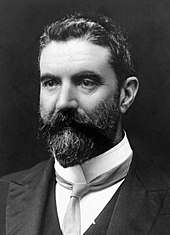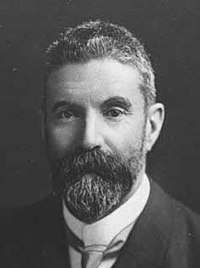Austin Chapman
Sir Austin Chapman KCMG (10 July 1864 – 12 January 1926) was an Australian politician who served in the House of Representatives from 1901 until his death in 1926. He held ministerial office in the governments of Alfred Deakin and Stanley Bruce, serving as Minister for Defence (1903–1904), Postmaster-General (1905–1907), Minister for Trade and Customs (1907–1908, 1923–1924), and Minister for Health (1923–1924).
Sir Austin Chapman KCMG | |
|---|---|
.jpg) | |
| Minister for Health | |
| In office 9 February 1923 – 26 May 1924 | |
| Prime Minister | Stanley Bruce |
| Preceded by | Walter Massy-Greene |
| Succeeded by | Herbert Pratten |
| Minister for Trade and Customs | |
| In office 9 February 1923 – 26 May 1924 | |
| Prime Minister | Stanley Bruce |
| Preceded by | Arthur Rodgers |
| Succeeded by | Herbert Pratten |
| In office 30 July 1907 – 13 November 1908 | |
| Prime Minister | Alfred Deakin |
| Preceded by | William Lyne |
| Succeeded by | Frank Tudor |
| Postmaster-General of Australia | |
| In office 5 July 1905 – 30 July 1907 | |
| Prime Minister | Alfred Deakin |
| Preceded by | Sydney Smith |
| Succeeded by | Samuel Mauger |
| Minister for Defence | |
| In office 24 September 1903 – 27 April 1904 | |
| Prime Minister | Alfred Deakin |
| Preceded by | James Drake |
| Succeeded by | Anderson Dawson |
| Member of the Australian Parliament for Eden-Monaro | |
| In office 29 March 1901 – 12 January 1926 | |
| Preceded by | New seat |
| Succeeded by | John Perkins |
| Personal details | |
| Born | Austen Chapman[1] 10 July 1864 Bong Bong, New South Wales, Australia |
| Died | 12 January 1926 (aged 61) Sydney, New South Wales, Australia |
| Political party | Protectionist (1901–09) Liberal (1909–17) Nationalist (1917–26) |
| Spouse(s) | Catherine O'Brien |
| Relations | Albert Chapman (brother) |
| Children | James Austin Chapman John Austin Chapman |
| Occupation | Company director |
Early life
Chapman was born on 10 July 1864 in Bong Bong, New South Wales. He was the son of Monica (née Cain; also spelt Kean or Kein) and Richard Chapman, his father being a wheelwright and publican. His mother was born in Ireland. His given name was spelled "Austen" until 1897.[1]
Chapman attended the state school in Marulan until the age of 14, when he was apprenticed to a saddler working in Goulburn and Mudgee. By 1885 he was operating Chapman's Hotel in Bungendore, close to the eventual site of Canberra. Chapman moved to Sydney in 1887 and went into partnership with Edward William O'Sullivan in an auctioneering firm, of which he was managing partner. He was also the proprietor of the Emu Inn on Bathurst Street. His partnership with O'Sullivan was dissolved in 1889, and he subsequently established the Royal Hotel in Braidwood.[1]
New South Wales politics
In 1894 he was elected to the New South Wales Legislative Assembly as MLA for Braidwood.[2] Like most politicians from the southern border regions of New South Wales, he was an active supporter of federation of the Australian colonies.
Federal politics
.jpg)
In 1901 Chapman was elected to the first House of Representatives as MP for the Division of Eden-Monaro (his brother Albert succeeded him as the member for Braidwood in the New South Wales Parliament). A Protectionist, he was Minister for Defence in the first ministry of Alfred Deakin (1903–04), Postmaster-General in the second Deakin ministry (1905–08), and Minister for Trade and Customs from 1907–08. After a long period on the backbench as a result of a stroke in 1909, which paralysed one of his arms, he was appointed Minister for Trade and Customs and Minister for Health in the Bruce government in February 1923. He was criticised by both Nationalists and the Country Party and he resigned in May 1924 on the grounds of ill health and was subsequently made a KCMG.[1]
Chapman's most important contribution was his influence on the choice of the site of Australia's national capital, Canberra. He lobbied hard for the site on the Molonglo River near Queanbeyan, in his electorate. The success of his lobbying benefited many of his friends who owned land in the area, and also greatly boosted trade in Queanbeyan, the nearest town to the site. He was still MP for Eden-Monaro at the time of his death in Sydney of cerebro-vascular disease. He was survived by his wife, two daughters and two sons, James Austin Chapman and John Austin Chapman who both became distinguished soldiers.[1][3] The Canberra suburb of Chapman was named after him.
References
- Gibbney, H. J. "Chapman, Sir Austin (1864–1926)". Australian Dictionary of Biography. Australian National University. Archived from the original on 22 March 2007. Retrieved 26 March 2007.
- "Sir Austin Chapman (1864–1956)". Former Members of the Parliament of New South Wales. Retrieved 13 May 2019.
- Thompson, Roger C. "Chapman, John Austin (1896–1963)". Australian Dictionary of Biography. Australian National University. Archived from the original on 22 March 2007. Retrieved 26 March 2007.
| Political offices | ||
|---|---|---|
| Preceded by James Drake |
Minister for Defence 1903–1904 |
Succeeded by Anderson Dawson |
| Preceded by Sydney Smith |
Postmaster-General 1905–1907 |
Succeeded by Samuel Mauger |
| Preceded by William Lyne |
Minister for Trade and Customs 1907–1908 |
Succeeded by Frank Tudor |
| Preceded by Arthur Rodgers |
Minister for Trade and Customs 1923–1924 |
Succeeded by Littleton Groom |
| Preceded by Walter Massy-Greene |
Minister for Health 1923–1924 |
Succeeded by Herbert Pratten |
| New South Wales Legislative Assembly | ||
| Preceded by Alexander Ryrie |
Member for Braidwood 1891–1901 |
Succeeded by Albert Chapman |
| Parliament of Australia | ||
| Preceded by New |
Member for Eden-Monaro 1901–1926 |
Succeeded by John Perkins |


.tif.png)